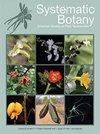哥伦比亚东部科迪勒拉一种极危菜叶属新种(千分亚,菊科)
IF 0.8
3区 生物学
Q4 EVOLUTIONARY BIOLOGY
引用次数: 0
摘要
摘要对哥伦比亚boyac本文章由计算机程序翻译,如有差异,请以英文原文为准。
Espeletia saboyana (Millerieae, Asteraceae), a New Critically Endangered Caulirosula from Cordillera Oriental, Colombia
Abstract Espeletia saboyana, a new species from Páramo de Saboyá, Boyacá department, Colombia, is described and illustrated. It is a caulescent rosette up to 5 m tall, with whitish-cinereous appearance, sessile leaves with elliptic laminae, cymose capitulescences with aphyllous unbranched portion and 3–5 capitula, 5–13 phyllaries, the external ones 17.4–26.0 mm long, 49–92 ray florets 13.0–18.4 mm long, and 162–347 disc florets 8.2–12.2 mm long. Espeletia saboyana is similar to E. incana, but with longer laminae, bigger foliar area, and fewer ray floret series. It is also similar to E. murilloi, but with longer ray tubes, ray paleae, disc corollas, disc styles, disc anther appendages, and disc paleae. In addition, E. saboyana is distributed allopatrically in regard to E. incana and E. murilloi. This species is informally proposed to be listed as IUCN Critically Endangered (CR), since it is restricted to a single population with extent of occurrence = 1.83 km2 and area of occupancy = 0.48 km2. Besides, this population is severely fragmented into 40–50 demes, the largest one covering only 34,000 m2. Most demes are found in humid soils and wetlands submitted to continuous habitat deterioration as water is drained for use in agriculture. Espeletia saboyana is rare or absent in these newly drained areas, which are either colonized by other species that thrive on drier soils or transformed into pastures for cattle grazing. Furthermore, analyses of size class distributions show that recruitment rates of E. saboyana are significantly lower in small demes, which, if not reversed, can further reduce population size in the near future.
求助全文
通过发布文献求助,成功后即可免费获取论文全文。
去求助
来源期刊

Systematic Botany
生物-进化生物学
CiteScore
1.80
自引率
10.00%
发文量
72
审稿时长
6-12 weeks
期刊介绍:
Systematic Botany Monographs is a series of peer-reviewed taxonomic monographs and revisions published the American Society of Plant Taxonomists. ISSN 0737-8211, ISBN prefix 978-0-912861. No; volumes of Systematic Botany Monographs must be ordered separately. ASPT membership inludes only a subscription to the quarterly journal Systematic Botany. SBM is supported by sales, author"s subsidies, and donations.
 求助内容:
求助内容: 应助结果提醒方式:
应助结果提醒方式:


